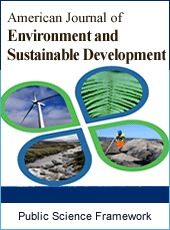American Journal of Environment and Sustainable Development
Articles Information
American Journal of Environment and Sustainable Development, Vol.5, No.3, Sep. 2020, Pub. Date: Sep. 28, 2020
Contribution of Marshland Development on Rice Production in Rwanda
Pages: 52-63 Views: 3040 Downloads: 1279
[01]
Narcisse Hakizimana, Faculty of Environmental Studies, University of Lay Adventists of Kigali (UNILAK), Kigali, Rwanda.
[02]
Lamek Nahayo, Faculty of Environmental Studies, University of Lay Adventists of Kigali (UNILAK), Kigali, Rwanda.
[03]
Abias Maniragaba, Faculty of Environmental Studies, University of Lay Adventists of Kigali (UNILAK), Kigali, Rwanda.
Rice is a most preferred food in rural and urban areas in Rwanda. The aim of this study was to analyze the contribution of marshland development on rice production in Rwanda, case of Rugende Marshland. The Authors based on hypotheses stating that there is no significant contribution to Rwanda rice production from Rugende marshland development project, and there is a significant contribution to Rwanda rice production resulting from Rugende marshland development project. This study used times series datasets of rice production collected from published Seasonal Agricultural Surveys (SAS) reports of the National Institute of Statistics of Rwanda (NISR) considered as baseline data. The Authors also employed the data collected from Rugende marshland rice farming cooperative formally registered in Rwanda Cooperative Agency (RCA) since April 19, 2018. Thereafter, the inferential statistics techniques such as linear regression, Correlation and Student’s “t” test were used throughout the Statistical Package for Social Sciences (SPSS) to compute the regression coefficients (α and β) and Pearson Correlation (r) for the analysis of findings. The correlation analysis revealed that there is a low correlation (0.25≤ r< 0.50) between sample dataset of Rugende paddy rice yield and national paddy rice yield, (Pearson correlation coefficient r = 0.395). The Student’s t test accepted the research hypothesis that there is no significant difference between national and Rugende marshland rice crop yield. This results lead to the conclusion that about 100 hectares of developed marshland leads to the contribution of 0.5 percent on national paddy rice production, in the same condition of agricultural technology. The government was recommended to provide sufficient improved rice seeds, increase training to rice farmers and conduct rice varieties to be grown on hillside.
Marshland Development, Irrigation, Rice Production, Rugende, Rwanda
[01]
Bas Bouman (2009). How much water does rice uses? International Rice Research Institute.
[02]
Aung Tun Oo, Guido Van Huylenbroecka and Stijn Speelman (2017). Differential impacts of an irrigation project: Case studof the Swar Dam Project in Yedashe, Bago region of Myanmar.
[03]
Kadigi, Reuben M. J, Girmay Tesfay, Alfred Bizoza, Genet Zinab (2012). "Irrigation and water use efficiency in Sub-Saharan Africa." Policy Research Paper 4.
[04]
John Kanburi Bidzakin, Simon C. Fialor, Dadson Awunyo-Vitor, and Iddrisu Yahaya (2018). Impact of Irrigation Ecology on Rice Production Efficiency in Ghana.
[05]
MINAGRI (2014). Ministry of Agriculture and Animal Resources. Annual Report FY 2013-2014.
[06]
National Institute of Statistics of Rwanda (2019). Seasonal Agricultural Survey. Annual report, 2019.
[07]
FAO, (2004). Rice and water: a long and diversified story.
[08]
MINAGRI (2016). Resettlement Action Plan (RAP) for the Proposed Project of Rehabilitation of Irrigation Facilities in Rwamagana district, Republic of Rwanda. Final report.
[09]
MINAGRI (2017). Sustainable Agricultural Intensification for Improved Livelihoods, Food Security and Nutrition Project (SAIP).
[10]
MINAGRI (2015). The Environmental Impact Assessment (EIA) and Environmental Management Plan (EMP) of works related to the development of irrigation infrastructure for crop production in Rugende marshland.
[11]
World Bank (2019). Third Rural Sector Support Project (P126440).
[12]
MINAGRI (2013). Rwanda’s Rice Commodity Chain Rwanda’s Rice Commodity Chain -Facing Globalization.
[13]
FAO (2018). The impact of markets and policy on incentives for rice production in Rwanda. Economics working paper 18-02. February 2018.
[14]
MINAGRI (2019). Annual Report 2018 – 2019.
[15]
RICE FOR AFRICA (2010). Coalition for African Rice Development (CARD). [Online]. Available at World Wide Web: https://riceforafrica.net/downloads/Countries/rwanda/Rwa_Brochure.pdf. Consulted on the 13th July 2020.
[16]
MINAGRI (2013). National Rice Development Strategy 2011-2018. Revised in 2013.
[17]
MINAGRI (2018). Strategic Plan for Agriculture Transformation 2018-24.
[18]
FAO (2001). Irrigation Water Management: Irrigation Methods.
[19]
Rwanda Cooperative Agency Website. http://www.rca.gov.rw/wemis/registration/. Consulted on 25th July 2020.
[20]
Dyah R. Panuju, Kei Mizuno, Bambang H. Trisasongko (2012). The dynamics of rice production in Indonesia 1961–2009.
[21]
Gbetondji Melaine Armel Nonvide (2017). Effect of Adoption of Irrigation on Rice Yield in the Municipality of Malanville, Benin. African Development Review, Vol. 29, No. S2, 2017, 109–120.
[22]
Klaus D. Kubinger, Dieter rasch & Marie Simeckova (2007). Testing a correlation coefficient’s significance: Using H0: 0 < p ≤ α is preferable to H0: p = 0. Psychology Science, Volume 49, 2007 (2), p. 74-87.

ISSN Print: Pending
ISSN Online: Pending
Current Issue:
Vol. 6, Issue 4, December Submit a Manuscript Join Editorial Board Join Reviewer Team
ISSN Online: Pending
Current Issue:
Vol. 6, Issue 4, December Submit a Manuscript Join Editorial Board Join Reviewer Team
| About This Journal |
| All Issues |
| Open Access |
| Indexing |
| Payment Information |
| Author Guidelines |
| Review Process |
| Publication Ethics |
| Editorial Board |
| Peer Reviewers |


